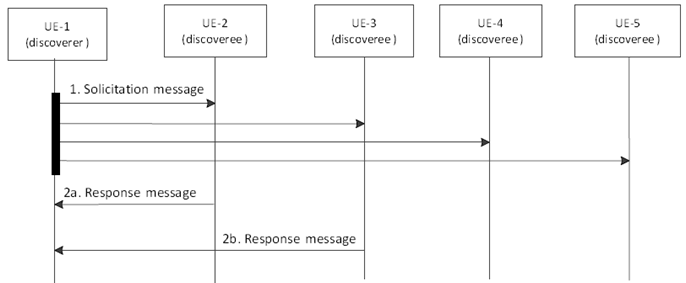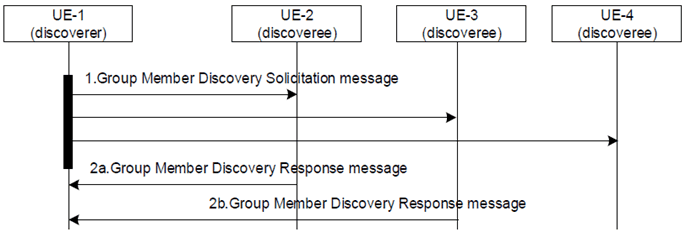Content for TS 23.304 Word version: 19.0.0
1…
4…
4.2.3…
4.2.7…
4.3…
5…
5.1.4…
5.1.5…
5.2…
5.3…
5.4…
5.5…
5.6…
5.7
5.8…
5.9…
6…
6.1.2…
6.2…
6.3…
6.3.2…
6.3.2.3…
6.3.2.4…
6.4…
6.4.3…
6.5…
6.5.2…
6.6…
6.7…
6.7.2…
6.8…
7…
7.2…
6.3.2 5G ProSe Direct Discovery procedures over PC5 reference point
6.3.2.1 General
6.3.2.2 Group Member Discovery
6.3.2.2.1 General
6.3.2.2.2 Procedure for Group Member Discovery with Model A
6.3.2.2.3 Procedure for Group Member Discovery with Model B
...
...
6.3.2 5G ProSe Direct Discovery procedures over PC5 reference point p. 86
6.3.2.1 General p. 86
A PC5 communication channel is used to carry the discovery message over PC5 and the discovery message over PC5 is differentiated from other PC5 messages by AS layer.
Both Model A and Model B discovery as defined in TS 23.303 are supported:
- Model A uses a single discovery protocol message (Announcement).
- Model B uses two discovery protocol messages (Solicitation and Response).

Step 1.
Depicted in Figure 6.3.2.1-2 is the procedure for 5G ProSe Direct Discovery with Model B.
The Announcing UE sends an Announcement message. The Announcement message may include the Type of Discovery Message, ProSe Application Code or ProSe Restricted Code, security protection element, [metadata information]. The Application layer metadata information may be included as metadata in the Announcement message.
The Destination Layer-2 ID and Source Layer-2 ID used to send the Announcement message are specified in clause 5.8.1.2 and clause 5.8.1.3.
The Monitoring UE determines the Destination Layer-2 ID for signalling reception. The Destination Layer-2 ID is configured with the UE(s) as specified in clause 5.8.1.2.

Step 1.
The Discoverer UE sends a Solicitation message. The Solicitation message may include Type of Discovery Message, ProSe Query Code, security protection element.
The Destination Layer-2 ID and Source Layer-2 ID used to send the Solicitation message are specified in clause 5.8.1.2 and clause 5.8.1.3.
How the Discoveree UE determines the Destination Layer-2 ID for signalling reception is specified in clause 5.8.1.2.
Step 2.
The Discoveree UE that matches the solicitation message responds to the Discoverer UE with the Response message. The Response message may include Type of Discovery Message, ProSe Response Code, security protection element, [metadata information]. The Application layer metadata information may be included as metadata in the Response message.
The Source Layer-2 ID used to send the Response message is specified in clause 5.8.1.3. The Destination Layer-2 ID is set to the Source Layer-2 ID of the received Solicitation message.
6.3.2.2 Group Member Discovery p. 87
6.3.2.2.1 General p. 87
Group Member Discovery is applicable to public safety use and commercial services. To perform Group Member Discovery, the UE is configured with the related information as described in clause 5.2.
Group Member Discovery is a form of restricted discovery in that only users that are affiliated with each other can discover each other (e.g. only users sharing the same Application Layer Group ID).
In the case of Public Safety use, the ProSe Restricted Code is not used for Group Member Discovery and pre-configured or provisioned information for the Discovery procedures as defined in clause 5.2 is used.
Both Model A and Model B discovery are supported:
- Model A uses a single discovery protocol message (Announcement).
- Model B uses two discovery protocol messages (Solicitation and Response).
6.3.2.2.2 Procedure for Group Member Discovery with Model A p. 88
Depicted in Figure 6.3.2.2.2-1 is the procedure for Group Member Discovery with Model A.

Step 1.
The announcing UE sends a Group Member Discovery Announcement message. The Group Member Discovery Announcement message includes the Type of Discovery Message, Announcer Info and Application Layer Group ID (See clause 5.8.1).
The Destination Layer-2 ID and Source Layer-2 ID used to send the Group Member Discovery Announcement message are specified in clause 5.8.1.2 and clause 5.8.1.3.
The Monitoring UE determines the Destination Layer-2 ID for signalling reception as specified in clause 5.8.1.2.
6.3.2.2.3 Procedure for Group Member Discovery with Model B p. 88
Depicted in Figure 6.3.2.2.3-1 is the procedure for Group Member Discovery with Model B.

Step 1.
The discoverer UE sends a Group Member Discovery Solicitation message. The Group Member Discovery Solicitation message includes the Type of Discovery Message, Discoverer Info, Application Layer Group ID and optionally Target Info (see clause 5.8.1).
The Destination Layer-2 ID and Source Layer-2 ID used to send the Group Member Discovery Solicitation message are specified in clause 5.8.1.2 and clause 5.8.1.3.
How the Discoveree UE determines the Destination Layer-2 ID for signalling reception is specified in clause 5.8.1.2.
Step 2.
The discoveree UEs that match the values of the parameters (including Application Layer Group ID and Target Info) contained in the solicitation message, responds to the discoverer UE with a Group Member Discovery Response message. The Group Member Discovery Response message includes the Type of Discovery Message, Discoveree Info and Application Layer Group ID (see clause 5.8.1).
The Source Layer-2 ID used to send the Group Member Discovery Response message is specified in clause 5.8.1.3. The Destination Layer-2 ID is set to the Source Layer-2 ID of the received Group Member Discovery Solicitation message.